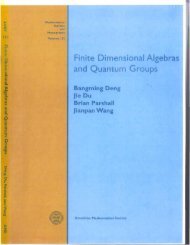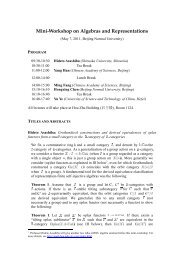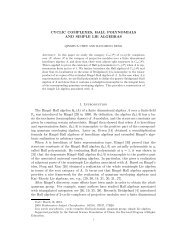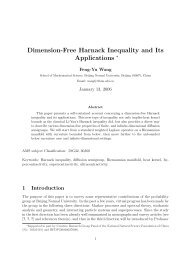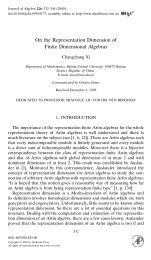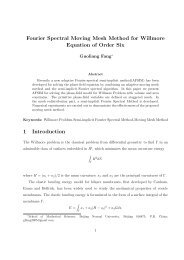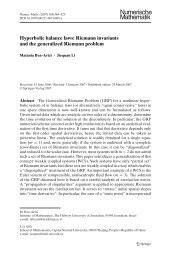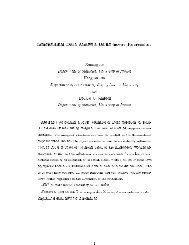Uniform Log-Sobolev inequality for Boltzmann measures with ...
Uniform Log-Sobolev inequality for Boltzmann measures with ...
Uniform Log-Sobolev inequality for Boltzmann measures with ...
You also want an ePaper? Increase the reach of your titles
YUMPU automatically turns print PDFs into web optimized ePapers that Google loves.
<strong>Uni<strong>for</strong>m</strong> <strong>Log</strong>-<strong>Sobolev</strong> <strong>inequality</strong> <strong>for</strong><br />
<strong>Boltzmann</strong> <strong>measures</strong> <strong>with</strong> exterior<br />
magnetic field over spheres ∗<br />
Zhengliang Zhang, † Bin Qian, ‡ Yutao Ma §<br />
April 2009<br />
Abstract<br />
In this paper, We obtain the uni<strong>for</strong>m <strong>Log</strong>-<strong>Sobolev</strong> <strong>inequality</strong> <strong>for</strong> the <strong>Boltzmann</strong><br />
<strong>measures</strong> by reducing multi-dimensional <strong>measures</strong> to one-dimensional<br />
<strong>measures</strong>, and then applying the characterization on the constant of <strong>Log</strong>-<br />
<strong>Sobolev</strong> <strong>inequality</strong> <strong>for</strong> a probability measure on the real line .<br />
Keywords: <strong>Boltzmann</strong> measure, <strong>Log</strong>-<strong>Sobolev</strong> <strong>inequality</strong>, T 2 -transportation <strong>inequality</strong>,<br />
Poincaré <strong>inequality</strong>.<br />
AMS Classification Subjects 2000: 60E15 39B62 26Dxx<br />
1 Introduction<br />
Let S n−1 be the unit sphere in R n (n ≥ 3), and µ the normalized Lebesgue measure<br />
on S n−1 , i.e. µ = σ n−1 /s n−1 , where σ n−1 and s n−1 are the uni<strong>for</strong>m surface measure<br />
and total volume respectively on S n−1 . For any h > 0 and e 1 = (1, 0, · · · , 0) ∈ S n−1 ,<br />
let µ h be the probability on S n−1 given by<br />
dµ h (x) = eh<br />
c n (h) dµ(x), x ∈ Sn−1 ,<br />
where c n (h) is the normalizing constant. This is the so-called <strong>Boltzmann</strong> measure<br />
<strong>with</strong> exterior magnetic field [9].<br />
∗ Research supported by National Science Funds of China (10626041, 10871153) and China<br />
Scholarship council 2007U13020.<br />
† Department of Mathematics and Statistics, Wuhan University, 430072-Hubei, China. E-mail<br />
address: zzl731205@yahoo.com.cn; zhlzhang.math@whu.edu.cn<br />
‡ Department of Mathematics and Statistics, Wuhan University, 430072-Hubei, China. E-mail<br />
address: binqiancn@yahoo.com.cn<br />
§ Department of Mathematics, Beijing Normal University, 100875-Beijing, China. E-mail address:<br />
mayt@bnu.edu.cn<br />
1
We say that a probability measure µ on a manifold X satisfies a logarithmic<br />
<strong>Sobolev</strong> <strong>inequality</strong> if there exists a constant C > 0 such that <strong>for</strong> every smooth<br />
function f : X → R, one has<br />
∫<br />
Ent µ (f 2 ) ≤ C |∇f| 2 dµ,<br />
where the entropy is defined by<br />
∫<br />
(∫<br />
Ent µ (f 2 ) = f 2 log f 2 dµ −<br />
) (∫<br />
f 2 dµ log<br />
)<br />
f 2 dµ .<br />
To be short we write µ ∈ LSI(C) <strong>for</strong> this <strong>inequality</strong>. Its property was well introduced<br />
by Gross [11]. Though here we just study the <strong>Log</strong>-<strong>Sobolev</strong> <strong>inequality</strong>, it’s<br />
well-known that Poincaré, transportation and <strong>Log</strong>-<strong>Sobolev</strong> inequalities are essential<br />
tools in the study of concentration of <strong>measures</strong> (see e.g. [12], [10]), and there exist<br />
some relations among the three types of inequalities: log-<strong>Sobolev</strong> <strong>inequality</strong> is<br />
strictly stronger than Talagrand’s transportation cost <strong>inequality</strong> ([12], [6] and [2]),<br />
which is stronger than Poincaré <strong>inequality</strong> (see [4], section 4.1).<br />
The main method we applied is to reduce the proof of the <strong>measures</strong> µ x on spheres<br />
to that of a probability <strong>measures</strong> ν x on [0, π], and then give an estimate on the<br />
characterization of a probability measure on R which satisfies a logarithmic <strong>Sobolev</strong><br />
<strong>inequality</strong>.<br />
2 Main result<br />
In this paper, we get the uni<strong>for</strong>m <strong>Log</strong>-<strong>Sobolev</strong> <strong>inequality</strong> in h > 0 <strong>for</strong> the <strong>Boltzmann</strong><br />
<strong>measures</strong>. The main results are shown as follows:<br />
Theorem 2.1. For any h > 0, the probability <strong>measures</strong> µ h satisfy the uni<strong>for</strong>m <strong>Log</strong>-<br />
<strong>Sobolev</strong> <strong>inequality</strong>, that is, <strong>for</strong> any smooth function f : S n−1 → R, the following<br />
<strong>inequality</strong> holds:<br />
Ent µh (f 2 ) ≤ C LS<br />
∫S n−1 |∇ S n−1f| 2 dµ,<br />
where C LS is independent of h > 0, but depends on the dimension n.<br />
We know that <strong>Log</strong>-<strong>Sobolev</strong> <strong>inequality</strong> is stronger than T 2 -transportation <strong>inequality</strong>,<br />
and T 2 -transportation <strong>inequality</strong> stronger than Poincaré <strong>inequality</strong>, so we have<br />
the following corollaries.<br />
Corollary 2.2. For any h > 0, the probability <strong>measures</strong> µ h ∈ P I(C P ), C P independent<br />
of h, that is, <strong>for</strong> any smooth function f : S n−1 → R, if the following <strong>inequality</strong><br />
holds:<br />
where C P is independent of h > 0.<br />
Var µh (f) ≤ C P<br />
∫S n−1 |∇ S n−1f| 2 dµ,<br />
2
Corollary 2.3. For any h > 0, the probability <strong>measures</strong> µ h ∈ T 2 (C), C independent<br />
of h.<br />
Remark: In fact, in [7], F.Q. Gao and L.M. Wu have already given the uni<strong>for</strong>m<br />
Poincaré <strong>inequality</strong> <strong>for</strong> the <strong>Boltzmann</strong> <strong>measures</strong>. Moreover, they find a more precise<br />
uni<strong>for</strong>m spectral gap. By their result on Poincaré <strong>inequality</strong> and an additional<br />
condition given by Miao and the first author in [15], we can also obtain Corollary<br />
2.3 quickly <strong>with</strong>out Theorem 2.1 .<br />
3 Idea of Proof<br />
In this paper, following an idea in [2], the method consists in reducing the proof<br />
to some one dimensional <strong>measures</strong> <strong>for</strong> which precise estimates of the log-<strong>Sobolev</strong><br />
constant are known see [3].<br />
Notice that the case h = 0, i.e. µ h = µ, is the simplest one, and <strong>for</strong> any h > 0<br />
fixed, it’s well-known that <strong>Log</strong>-<strong>Sobolev</strong> <strong>inequality</strong> holds <strong>for</strong> the <strong>measures</strong> µ h , so we<br />
just need to consider the cases that h is large enough. Through the whole paper,<br />
we assume that h is large enough.<br />
Let ν h be the image of µ h by the map x → d(e 1 , x). It is a probability on [0, π]<br />
<strong>with</strong> density<br />
ρ n,h := dν h<br />
dθ = 1<br />
C n (h) eh cos θ (sin θ) n−2 ,<br />
where C n (h) is the normalizing constant, whose order of h is e h h − n−1<br />
2 as h goes to<br />
infinity (see Lemma 5.1).<br />
In [2], F. Barthe and the first author give the following lemma, which makes it<br />
possible <strong>for</strong> us to reduce to the discussion on one-dimensional <strong>measures</strong>.<br />
Lemma 3.1. Let λ be a probability measure on S n−1 <strong>with</strong><br />
dλ(x) = φ(d(x, e 1 ))dσ n−1 (x), x ∈ S n−1 ,<br />
where φ is measurable. Let ν be the image of λ by the map x → d(x, e 1 ). Assume that<br />
ν satisfies a <strong>Log</strong>-<strong>Sobolev</strong> <strong>inequality</strong> <strong>with</strong> constant C LS , then λ satisfies a <strong>Log</strong>-<strong>Sobolev</strong><br />
<strong>inequality</strong> <strong>with</strong> constant max(C LS , c n−2 ), where c n−2 is the <strong>Log</strong>-<strong>Sobolev</strong> constant of<br />
the uni<strong>for</strong>m probability σ n−2 /s n−2 on S n−2 , that is, <strong>for</strong> every smooth function f :<br />
S n−1 → R,<br />
∫<br />
Ent λ (f 2 ) ≤ max(C LS , c n−2 ) |∇ S n−1f| 2 dλ.<br />
S n−1<br />
As far as the measure µ h is concerned, by the Lemma 3.1 we just need to discuss<br />
the measure ν h . The generator associated <strong>with</strong> ν h is<br />
L h f(θ) = d2<br />
dθ 2 f + (−h sin θ + (n − 2) cot θ) d dθ f<br />
It’s well-known that Bakry-Emery criteria gives a curvature condition to get the<br />
<strong>Log</strong>-<strong>Sobolev</strong> <strong>inequality</strong>. However, the curvature condition requires a non-negative<br />
lower bound.<br />
3
Theorem 3.2. (Bakry and Emery [1]) Let dν = e −Ψ dx be a probability measure<br />
on a manifold M, such that Ψ ∈ C 2 (M) and D 2 Ψ + Ric ≥ ρI n , ρ > 0. Then<br />
dν ∈ LSI(ρ).<br />
For the measure dν h = e h cos θ (sin θ) n−2 dθ/C n (h) on [0, π], we have<br />
Ψ = −(h cos θ + (n − 2) log sin θ) + log C n (h),<br />
D 2 Ψ = h cos θ + (n − 2) csc 2 θ.<br />
Since θ = π − ε the second derivative D 2 Ψ behaves like −h + (n − 2)ε −2 , the<br />
curvature (or the second derivative if you prefer) is not bounded below by some<br />
positive constant <strong>for</strong> all h, and then Bakry-Emery criterion does not apply.<br />
4 Proofs of main result<br />
Here we’ll make use of the refined characterization from Barthe and Roberto [3]. Of<br />
course, we may also use that one from Bobkov, and Götze [5], after all, we don’t<br />
want to give a sharp estimate on the logarithmic <strong>Sobolev</strong> constants. Now we state<br />
the refined characterization as follows.<br />
Theorem 4.1. ([3]) Let µ, ν be Borel <strong>measures</strong> on R <strong>with</strong> µ(R) = 1 and dν(x) =<br />
n(x)dx. Let m be a median of µ. Let C be the optimal constant such that <strong>for</strong> every<br />
smooth function f : R → R, one has<br />
∫<br />
Ent µ (f 2 ) ≤ C f ′2 dν.<br />
Then max(b − , b + ) ≤ C ≤ 4 max(B − , B + ), where<br />
(<br />
) ∫<br />
1<br />
x<br />
1<br />
b + = sup µ([x, ∞)) log 1 +<br />
x>m<br />
2µ([x, ∞)) m n ,<br />
(<br />
)<br />
e 2 ∫ x<br />
1<br />
B + = sup µ([x, ∞)) log 1 +<br />
x>m<br />
µ([x, ∞)) m n ,<br />
(<br />
) ∫<br />
1<br />
m<br />
1<br />
b − = sup µ((−∞, x]) log 1 +<br />
x
where m h is the median of ν h , and it tends to 0 as h → +∞ (see Lemma 5.2 in<br />
appendix part). Moreover, we also give the speed rate of m h : there exist positive<br />
constants M 0 , M, s.t. M 0 ≤ h(1 − cos m h )) ≤ M (see Lemma 5.3).<br />
By a change of variables θ = arccos x, <strong>for</strong> arbitrary α, β ∈ (0, π), we have<br />
∫ β<br />
α<br />
ρ n,h (θ)dθ =<br />
∫ β<br />
α<br />
∫ β<br />
α<br />
e h cos θ (sin θ) n−2<br />
C n (h)<br />
1<br />
ρ n,h (θ) dθ =<br />
∫ cos α<br />
cos β<br />
∫ cos α<br />
dθ =<br />
cos β<br />
C n (h)<br />
e hx (1 − x 2 ) n−1<br />
2<br />
e hx (1 − x 2 ) n−3<br />
2<br />
C n (h)<br />
Since we just want to prove that C LS is bounded, c = 1/2 or c = e 2 has no direct<br />
influence on our proof. For simplicity, we’ll just estimate S − (h, 1) and S + (h, 1),<br />
denoted by S − (h), and S + (h) respectively <strong>for</strong> short. In order to avoid some trouble,<br />
we’ll denote all the constants independent of h by the uni<strong>for</strong>m constant C.<br />
(I) First we study the supper bound on S − (h). Let r = h(1 − t),<br />
S − (h) =<br />
sup<br />
α∈(0,m h )<br />
= sup<br />
t∈(cos m h ,1)<br />
(∫ α<br />
)<br />
ρ n,h (θ)dθ log<br />
0<br />
∫ 1<br />
·<br />
t<br />
(<br />
1 +<br />
e hx (1 − x 2 ) n−3<br />
2 dx log<br />
(1 +<br />
( ∫ t<br />
cos(m h )<br />
dx<br />
e hx (1 − x 2 ) n−1<br />
2<br />
1<br />
∫ α<br />
ρ 0 n,h(θ)dθ<br />
Since 0 < cos m h < t < 1 (when h is large enough), we have<br />
∫ 1<br />
t<br />
∫ 1<br />
e hx (1 − x) n−3<br />
2 dx ≤<br />
∫ 1<br />
t<br />
t<br />
)<br />
e hx (1 − x 2 ) n−3<br />
n−3<br />
2 dx ≤ 2 2<br />
e hx (1 − x) n−3<br />
2 dx =<br />
e h<br />
h n−1<br />
2<br />
.<br />
∫ h(1−t)<br />
0<br />
dx.<br />
α<br />
dx,<br />
) (∫ mh<br />
)<br />
1<br />
ρ n,h (θ) dθ<br />
C n (h)<br />
∫ 1<br />
t<br />
ehx (1 − x 2 ) n−3<br />
2 dx<br />
∫ 1<br />
t<br />
e −y y n−3<br />
2 dy,<br />
and (noting that 0 < M 0 ≤ h(1 − cos m h ) ≤ M (see Lemma 5.3))<br />
)<br />
e hx (1 − x) n−3<br />
2 dx,<br />
∫ t<br />
cos(m h )<br />
dx<br />
e hx (1 − x 2 ) n−1<br />
2<br />
≤ h ∫ n−3<br />
2 h(1−cos mh )<br />
e h h(1−t)<br />
e y dy<br />
y n−1<br />
2<br />
≤ h n−3<br />
2<br />
e h<br />
∫ M<br />
h(1−t)<br />
e y dy<br />
,<br />
y n−1<br />
2<br />
Thus <strong>with</strong> C n (h)h n−1<br />
2 e −h ≤ C (see Lemma 5.1)), we get<br />
S − (h) ≤<br />
≤<br />
sup<br />
r∈(0,M)<br />
sup<br />
r∈(0,M)<br />
2 n−3<br />
2<br />
h<br />
2 n−3<br />
2<br />
h<br />
∫ r<br />
0<br />
r n−1<br />
2<br />
n−1<br />
2<br />
2 n+1<br />
2 e M<br />
≤<br />
(n − 1)(n − 3) · 1<br />
h<br />
e −y y n−3<br />
2 dy log<br />
(1 +<br />
(<br />
log<br />
1 + n − 1<br />
2<br />
(<br />
sup r log<br />
r∈(0,M)<br />
C<br />
∫ r<br />
0 e−y y n−3<br />
Cr − n−1<br />
2<br />
) e<br />
M<br />
2 dy<br />
n−3<br />
r − n−3<br />
2<br />
2<br />
1 + n − 1 Cr − n−1<br />
2<br />
2<br />
) (∫ M<br />
)<br />
r<br />
)<br />
e y dy<br />
y n−1<br />
2<br />
5
Clearly, S − (h) is uni<strong>for</strong>mly bounded in h > 0.<br />
(II) Second we study the supper bound on S + (h).<br />
(∫ π<br />
) (<br />
) (∫<br />
1<br />
α<br />
)<br />
1<br />
S + (h) = sup ρ n,h (θ)dθ log 1 + ∫ π<br />
α∈(m h ,π) α<br />
ρ α n,h(θ)dθ m h<br />
ρ n,h (θ) dθ<br />
∫ )<br />
t<br />
= sup e hx (1 − x 2 ) n−3<br />
C n (h)<br />
2 dx log<br />
(1 + ∫ t<br />
t∈(−1,cos m h ) −1<br />
−1 ehx (1 − x 2 ) n−3<br />
2 dx<br />
( ∫ )<br />
cos mh<br />
dx<br />
·<br />
t<br />
e hx (1 − x 2 ) n−1<br />
2<br />
(1) When −1 < t < 0,<br />
First we work on the first term of S + (h) in the right hand side,<br />
∫ t<br />
−1<br />
∫ t<br />
e hx (1 − x 2 ) n−3<br />
n−3<br />
2 dx ≤ 2 2<br />
then on the third term,<br />
−1<br />
e hx (1 + x) n−3 2 n−3<br />
2<br />
2 dx ≤<br />
h n−1<br />
0<br />
2 e h ∫ h(1+t)<br />
e y y n−3<br />
2 dy,<br />
∫ cos mh<br />
t<br />
dx<br />
e hx (1 − x 2 ) n−1<br />
2<br />
≤<br />
∫ 0<br />
t<br />
dx<br />
e hx (1 + x) n−1<br />
2<br />
+<br />
∫ cos mh<br />
0<br />
dx<br />
e hx (1 − x) n−1<br />
2<br />
,<br />
notice that<br />
∫ cos mh<br />
0<br />
dx<br />
e hx (1 − x) n−1<br />
2<br />
∫ cos mh<br />
≤ 2 n−1<br />
2 +<br />
1/2<br />
≤ 2 n−1<br />
2 +<br />
dx<br />
e hx (1 − x) n−1<br />
2<br />
e −h/2 h n−1<br />
2<br />
(h(1 − cos m h )) n−1<br />
2<br />
≤ C (independent of h),<br />
and<br />
∫ 0<br />
t<br />
dx<br />
e hx (1 + x) n−1<br />
2<br />
∫ h<br />
= h n−3<br />
2 e<br />
h<br />
h(1+t)<br />
dy<br />
e y y n−1<br />
2<br />
∫ +∞<br />
≤ h n−3<br />
2 e<br />
h<br />
h(1+t)<br />
dy<br />
e y y n−1<br />
2<br />
.<br />
Let q = h(1 + t), by the monotonicity of x log(1 + C ) in x > 0,<br />
x<br />
S + (h) ≤ sup C2 n−3<br />
2<br />
q∈(0,h)<br />
+ sup<br />
q∈(0,h)<br />
2 n−3<br />
2<br />
h<br />
h n−1<br />
∫ q<br />
0<br />
∫<br />
1 q<br />
2 e h<br />
0<br />
e y y n−3<br />
2 dy log<br />
(<br />
=: sup I 1 (h) + sup I 2 (h).<br />
q∈(0,h)<br />
q∈(0,h)<br />
i). When lim h→+∞ q = 0,<br />
e y y n−3<br />
2 dy log<br />
(<br />
6<br />
1 + h n−1<br />
2 e h C n (h)<br />
1 + h n−1<br />
2 e h C n (h)<br />
∫<br />
2 n−3 q<br />
2<br />
0 ey y n−3<br />
∫<br />
2 n−3 q<br />
2<br />
0 ey y n−3<br />
2 dy<br />
2 dy<br />
) ∫ +∞<br />
q<br />
)<br />
dy<br />
e y y n−1<br />
2
I 2 (h) ≤ 2 n−3<br />
2<br />
h<br />
= 2 n−3<br />
2<br />
n−1<br />
2<br />
∫ q<br />
0<br />
n−3<br />
2<br />
y n−3<br />
2 dy<br />
∫ +∞<br />
q n−1<br />
2<br />
h<br />
1<br />
q n−3<br />
2<br />
≤C q (<br />
)<br />
h log 1 + Ce 2h q − n−1<br />
2 → 0.<br />
I 1 (h) → 0,<br />
)<br />
dy<br />
log<br />
(1 + h n−1<br />
2 e h C n (h)<br />
∫<br />
q y n−1<br />
2 2 n−3 q<br />
2 y n−3<br />
2 dy<br />
0<br />
(<br />
n−1<br />
2<br />
log 1 +<br />
h )<br />
n−1<br />
2 e h C n (h)<br />
, (C<br />
2 n−3<br />
2 q n−1<br />
n (h) ∼ eh<br />
2<br />
ii). When lim h→+∞ q = +∞ : note that 0 < q < h,<br />
(<br />
)<br />
I 1 (h) ≤ C2 n−3 q n−3<br />
2 e q<br />
2<br />
h n−1<br />
2 e log 1 + h n−1<br />
2 e h C n (h)<br />
h 2 n−3<br />
2 q n−3<br />
2 e q<br />
≤ C log(1 + Ce2h )<br />
h<br />
I 2 (h) ≤ 2 n−3<br />
2 q n−3<br />
2 e q<br />
log(1 + Ce 2h )e −q 2 n−3<br />
q− 2 = C log(1 + Ce2h )<br />
h<br />
n − 3 h<br />
h n−1<br />
2<br />
Clearly I 1 (h), I 2 (h) are bounded in h in the case −1 < t < 0, so is S + (h).<br />
(2) When 0 ≤ t < cos m h :<br />
Let p = h(1 − t) ≥ h(1 − cos m h ) ≥ M 0 > 0,<br />
∫ t<br />
−1<br />
∫ cos mh<br />
t<br />
∫ t<br />
e hx (1 − x 2 ) n−3<br />
n−3<br />
2 dx ≤ 2 2<br />
dx<br />
e hx (1 − x 2 ) n−1<br />
2<br />
≤ h n−3<br />
2<br />
e h<br />
−1<br />
e hx (1 − x) n−3 2 n−3<br />
2 e h<br />
2 dx ≤<br />
∫ h(1−t)<br />
h(1−cos m h )<br />
By the monotonicity of x log(1 + C ) in x > 0,<br />
x<br />
S + (h) ≤<br />
≤<br />
sup<br />
p∈(M 0 ,2h)<br />
sup<br />
p∈(M 0 ,2h)<br />
·<br />
2 n−3<br />
2<br />
h<br />
(∫ p<br />
·<br />
2 n−1<br />
2<br />
p<br />
( ∫ p/2<br />
M 0<br />
∫ 2h<br />
p<br />
e −y y n−3<br />
2 dy log<br />
(<br />
e y y − n−1<br />
h(1−cos m h )<br />
∫ +∞<br />
p<br />
2 dy<br />
)<br />
e −y y n−3<br />
2 dy log<br />
(1 +<br />
e y y − n−1<br />
2 dy +<br />
∫ p<br />
p/2<br />
h n−1<br />
2<br />
e y y − n−1 h n−3<br />
2<br />
2 dy ≤<br />
e h<br />
∫ 2h<br />
p<br />
∫ p<br />
1 + e−h h n−1<br />
2 C n (h)<br />
2 n−3<br />
2<br />
∫ +∞<br />
∫ 2h<br />
p<br />
e −y y n−3<br />
2 dy<br />
C<br />
)<br />
e −y y n−3<br />
2 dy,<br />
M 0<br />
e y y − n−1<br />
2 dy.<br />
)<br />
)<br />
e<br />
p<br />
−y y n−3<br />
2 dy<br />
)<br />
e y y − n−1<br />
2 dy , (C n (h) ∼ eh<br />
h n−1<br />
2<br />
).<br />
7
Notice that<br />
∫ +∞<br />
p<br />
e −y y n−3<br />
n−1<br />
2 dy ≤ p 2<br />
∫ +∞<br />
1<br />
= e −p p n−1<br />
2<br />
≤ Ce −p p n−1<br />
2<br />
≤ Ce −p p n−3<br />
2 .<br />
e −pz z n−3<br />
2 dz<br />
∫ +∞<br />
0<br />
∫ +∞<br />
Then by the monotonicity of x log(1 + C ), we have<br />
x<br />
)<br />
S + (h) ≤<br />
≤<br />
sup<br />
p∈(M 0 ,2h)<br />
sup<br />
p∈(M 0 ,+∞)<br />
2 n−1<br />
2 Cp n−3<br />
2<br />
pe p<br />
C<br />
(<br />
e − p 2 p<br />
n−3<br />
(<br />
log<br />
0<br />
e −pz (z + 1) n−3<br />
2 dz<br />
e −pz e M 0z/2 dz<br />
(<br />
1 + Ce p p − n−3 2<br />
2 ·<br />
n − 3<br />
(<br />
) log<br />
2<br />
0 + 2 n−3<br />
2<br />
p<br />
2 M<br />
− n−3<br />
e p 2<br />
M n−3<br />
2<br />
0<br />
1 + Ce p p n−3<br />
2<br />
)<br />
+ ep 2 n−3<br />
2<br />
p n−3<br />
2<br />
From the quality above, we see that S + (h) is still bounded as p → +∞. There<strong>for</strong>e,<br />
we get that S + (h) is bounded in h in the case 0 < t < cos m h .<br />
Summarizing the cases (1) and (2), we obtain S + (h) is uni<strong>for</strong>mly bounded in<br />
h > 0.<br />
By the boundness of S − (h) and S + (h) and Theorem 4.1, we finish our proof.<br />
.<br />
)<br />
5 Appendix<br />
Lemma 5.1. There exist positive constants C 1 (n) and C 2 (n) such that <strong>for</strong> say h ≥ 1,<br />
C 1 (n)e h h − n−1<br />
2 ≤ C n (h) ≤ C 2 (n)e h h − n−1<br />
2 .<br />
Lemma 5.2. The median m h of the measure ν h tends to 0 as h → +∞.<br />
Proof. By the definition of median, we have<br />
∫ π<br />
e h cos θ (sin θ) n−2 dθ = C n(h)<br />
m h<br />
2<br />
However<br />
∫ π<br />
m h<br />
e h cos θ (sin θ) n−2 dθ =<br />
∫ cos mh<br />
−1<br />
≤ 2 n−3<br />
2 + 2 n−3<br />
2<br />
= 2 n−3<br />
2 + 2 n−3<br />
2<br />
e hx (1 − x 2 ) n−3<br />
2 dx<br />
∫ cos mh<br />
0<br />
e h<br />
h n−1<br />
2<br />
∫ h<br />
∼ e h h − n−1<br />
2 .<br />
e hx (1 − x) n−3<br />
2 dx<br />
h(1−cos m h )<br />
e −y y n−3<br />
2 dy<br />
∼ e h cos mh · {(1 − cos m h ) n−3<br />
2 h<br />
−1 ∨ h − n−1<br />
2 } (as h large).<br />
8
By the comparison of the order of h, cos m h must tend to 1 as h → +∞. Thus<br />
we reach the conclusion required.<br />
Lemma 5.3. {h(1 − cos m h ); h > 0} is uni<strong>for</strong>mly bounded in h. Moreover, there<br />
exist positive constants M 0 , M, s.t. 0 < M 0 ≤ h(1 − cos m h ) ≤ M when h is large<br />
enough.<br />
Proof. Since<br />
and by lim h→+∞ cos m h = 1<br />
∫ mh<br />
0<br />
e h cos θ (sin θ) n−2 dθ = C n(h)<br />
,<br />
2<br />
We have<br />
∫ mh<br />
0<br />
∫ 1<br />
e h cos θ (sin θ) n−2 dθ = e hx (1 − x 2 ) n−3<br />
2 dx<br />
cos m h<br />
≃2 n−3<br />
2<br />
∫ 1<br />
=2 n−3<br />
2 e h h − n−1<br />
2<br />
cos m h<br />
e hx (1 − x) n−3<br />
2 dx<br />
∫ h(1−cos mh )<br />
0<br />
e −y y n−3<br />
2 dy,<br />
∫ h(1−cos mh )<br />
0<br />
e −y y n−3<br />
2 dy ≃ 2<br />
1−n<br />
2 e −h h n−1<br />
2 Cn (h)<br />
{<br />
≤ 2 1−n<br />
2 e −h h n−1<br />
2 2 n−3<br />
2 + 2 n−3<br />
2<br />
≤ 1 2 h n−1<br />
2 e −h + 1 2<br />
→ 1 2<br />
∫ +∞<br />
0<br />
∫ +∞<br />
0<br />
e h<br />
h n−1<br />
2<br />
e −y y n−3<br />
2 dy<br />
∫ +∞<br />
e −y y n−3<br />
2 dy (as h → +∞).<br />
0<br />
e −y y n−3<br />
2 dy<br />
}<br />
Clearly, by the <strong>inequality</strong> above we know that h(1−cos m h ) doesn’t tend to infinity<br />
as h → +∞, that is, {h(1 − cos m h ); h > 0} uni<strong>for</strong>mly bounded in h. Moreover,<br />
from lim h→+∞ 2 1−n<br />
2 e −h h n−1<br />
2 C n (h) > 0, we have<br />
lim h(1 − cos m h) > 0.<br />
h→+∞<br />
Example : When n = 3, dν h (θ) = eh cos θ sin θ<br />
dθ, where C 3 (h) is the normalized<br />
C 3 (h)<br />
constant, given as follows:<br />
C 3 (h) =<br />
∫ π<br />
0<br />
e h cos θ sin θdθ = eh − e −h<br />
.<br />
h<br />
9
m h is the median of ν h , by the definition of median, we have<br />
Then<br />
Moreover,<br />
∫ mh<br />
0<br />
e h cos θ (sin θ) n−2 dθ = C 3(h)<br />
,<br />
2<br />
( )<br />
1<br />
m h = arccos<br />
h log eh + e −h<br />
.<br />
2<br />
lim h(1 − cos m h) = log 2.<br />
h→+∞<br />
References<br />
[1] D. Bakry and M. Emery, Diffusions hypercontractivies, In Sém. Proba. XIX,<br />
LNM, 1123, Springer (1985), 177-206.<br />
[2] F. Barthe and Z.L. Zhang, Poincare, transportation and logarithmic <strong>Sobolev</strong><br />
inequalities <strong>for</strong> harmonic <strong>measures</strong> on spheres, to submit.<br />
[3] F. Barthe and C. Roberto, <strong>Sobolev</strong> inequalities <strong>for</strong> probabilty <strong>measures</strong> on the<br />
real line, Studia Mathematica, 159 (3) (2003), 481-497.<br />
[4] S. G. Bobkov, I. Gentil and M. Ledoux, Hypercontractivity of Hamilton-Jacobi<br />
equations, J. Math. Pures Appl. 80 (2001) 669-696.<br />
[5] S. G. Bobkov and F. Götze, Exponential integrability and transportation cost<br />
related to logarithmic <strong>Sobolev</strong> inequalities, J. Funct. Anal. 163 (1999), 1-28.<br />
[6] P. Cattiaux and A. Guillin, On quadratic transpotation cost inequalities, J.<br />
Math. Pures Appl. 86 (2006) 342-361.<br />
[7] F.Q. Gao and L.M. Wu, Transportatoin-In<strong>for</strong>mation inequalities <strong>for</strong> Gibbs<br />
<strong>measures</strong>. (in preparation)<br />
[8] H. Gjellout, A. Guillin and L. Wu, Transportation cost-in<strong>for</strong>mation inequalities<br />
and applications to random dynamical systems and diffusons, Ann. Proba., Vol<br />
32, No. 3B (2004), 2702-2732.<br />
[9] J. Glimm and A. Jaffe, Quantum Physics, A Functional Integral Point of View,<br />
Springer-Verlag, New York Heidelberg Berlin.<br />
[10] A. Guionnet and B. Zegarlinski, Lectures on logarithmic <strong>Sobolev</strong> inequalities,<br />
in: Séminaire de Probabilité XXXVI, Lecture Notes in Math. 1801, Springer,<br />
Berlin, 2003, 1-134.<br />
[11] L. Gross, <strong>Log</strong>arithmic <strong>Sobolev</strong> inequalities, Amer. J. Math. 97 (1975), 1061-<br />
1083.<br />
10
[12] M. Ledoux, The Concentration of Measures Phenomenon, Math. Surveys Monographs<br />
89, Amer. Math. Soc., Providence, RI, 2001.<br />
[13] K. Marton, Bounding ¯d-distance by in<strong>for</strong>mational divergence: a method to<br />
prove measure concentration, Ann. Prob. 24 (1996) 857-866.<br />
[14] F. Otto and C. Villani, Generalization of an <strong>inequality</strong> by Talagrand and links<br />
<strong>with</strong> the logarithmic <strong>Sobolev</strong> <strong>inequality</strong>, J. Funct. Anal. 173 (2000), no. 2, 361–<br />
400.<br />
[15] Z.L. Zhang and Y. Miao, An equivalent condition between Poincare <strong>inequality</strong><br />
and T 2 -transportation cost <strong>inequality</strong>, Acta Appl. Math.DOI 10.1007/s10440-<br />
008-9379-z.<br />
11



